This is the fourth entry in the series about my trip to North Korea
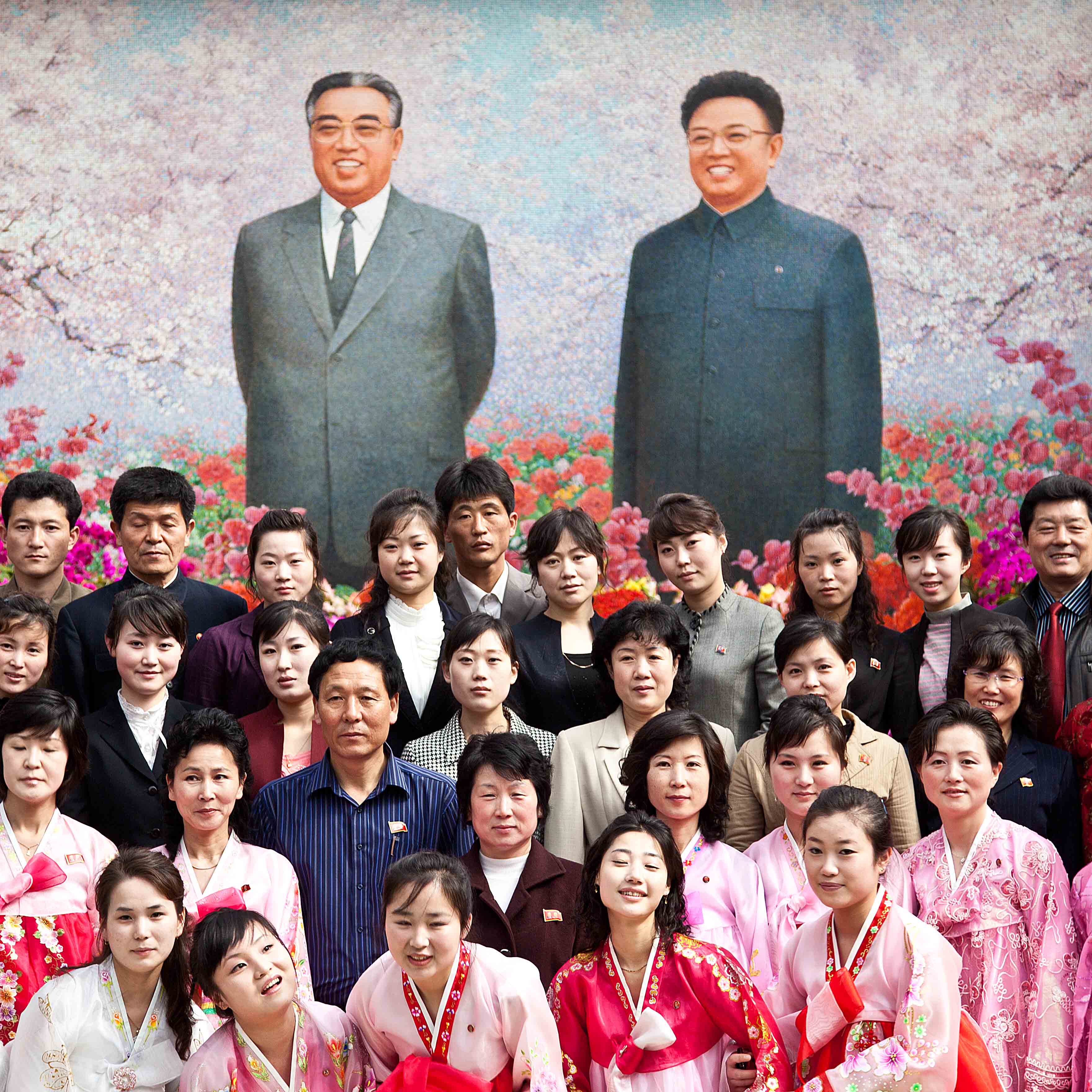
At the annual Kim il Sung Flower Exhibition in Pyongyang, photo courtesy of Roc LaMontagne
In North Korea, the images of the Great Leader Kim il Sung and the Great General Kim Jong il are everywhere. This is not a Soviet-style cult of personality. Leader-worship here is a full-fledged religion.
Going to the annual art show is like following the Stations of the Cross: Kim il Sung at his birthplace, Mangyongdae, Kim il Sung as a guerrilla fighting the Japanese, Kim il Sung signing the armistice, Kim Jong il as a boy at school instructing the other children, Kim Jong il at the factory with the workers. The system even has its own strange numerology: a model of an ancient Korean battle ship will be constructed so that its length in meters corresponds to the date upon which the Worker's party was founded -- as if anyone notices.
I suppose the faithful do. I expect they remember it like catechism. If by chance, one were to forget, the words of the great leaders, common-sense platitudes like: "Plant more crops, harvest more rice" are inscribed like the Ten Commandments on two-ton slabs of rock.
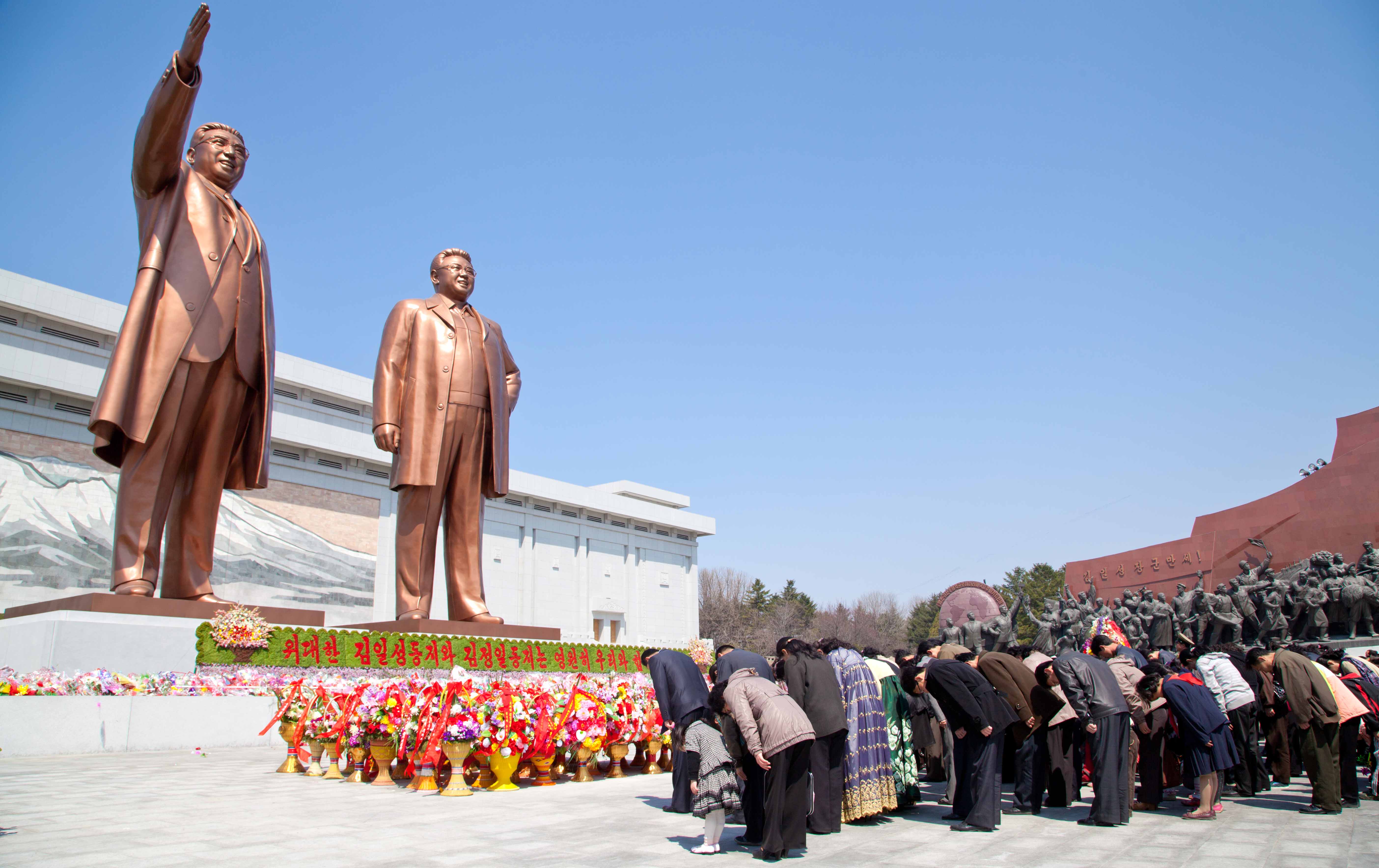
Bowing at Mansundae Grand Monument , photo courtesy of Roc LaMontagne
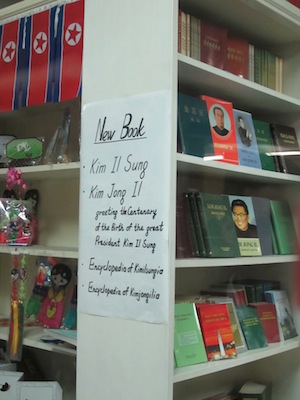
A souvenir shop at the best hotel in Pyongyang
We try not to laugh, but sometimes, it's impossible not to make fun. At the Agricultural University at Wonson, a little red triangle demarcates exactly where Kim Jong il stood when he had his picture taken. Some of us take turns posing there. Apparently, the Great General didn't like the shadows that showed up in the photo, so he chose another spot that is now demarcated with a little green triangle.
The local guide tells us that during the Korean War, Kim Jong il accompanied his father to an airstrip where he gave bomber pilots advice on fighting the enemy. I turn to a fellow traveler, "Wouldn't he have been about five years old?"
"Don't you know," he quips, "Kim Jong il crawled out of his mother's vagina and started giving instruction on how to give birth!"
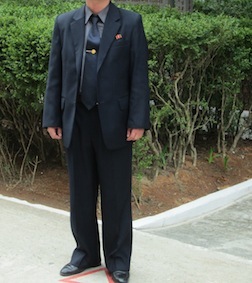
In the footsteps of greatness
We don't talk like this in front of the lovely Miss Choi. She seems to believe it all: Juche (Kim il-Sung's philosophy of complete self reliance and man's domination of the universe) and that the Great leader and the Great General are the suns of mankind. She is not a robot. It is simply that to not believe would leave her and most North Koreans utterly bereft of a national identity. To understand this, you must understand the history of Korea.
Imagine if your country were occupied for 40 years, if you were forced to speak another language and even had to take a different name. Ancestry in Korea is everything. Before the Japanese invaded it was more strictly Confucian than China. Then, imagine that the Japanese leave and another powerful country comes in, hands a pen to two lowly colonels, puts them in a room with a map and tells them not to come out until they've split the country in two. Thus the 38th parallel was born.
Why did the U.S. stay? Did we suddenly realize that Korea was a sovereign nation and decide to help this fledgling democracy? Did we feel guilty that, in 1918, we told Korean nationalists, inspired by our own President Wilson's Fourteen Points, to get lost because we thought Japan was a safer economic bet? Or was it that we wanted to preserve capitalist markets in Asia, and, Korea, situated between China and the Soviet Union, was too strategically important and too backward to govern itself?
One thing is certain: By 1950 both sides wanted forced unification, i.e. war. Kim il Sung made the first move. The U.S. (or, more accurately, a trumped up U.N. coalition of the willing) responded by killing 2 million people and decimating every form of industry. North Korea was left a wasteland.
Even if the U.S. did not maintain thousands of troops in South Korea, I think the North Koreans would have a war mentality. Better isolation than that other slavery. Better to believe in your leaders and your system than admit you have no power. One fact, proudly relayed to us by Ms. Choi, says it all: The Pueblo -- the captured U.S. navy vessel is moored in the Taedong River in Pyongyang -- towed as a war-trophy to the very spot where, over a hundred years ago, the armed American merchant vessel the General Sherman demanded that Korea open itself up to trade.
The Pueblo was captured by the North Koreans in 1968. After a gun-battle, the crew was kept as prisoners in Pyongyang until then President Johnson issued a written apology. It is a real point of pride with the North Koreans and is a "must-see" tourist attraction. They pack us into a small room below decks to watch a video about the incident.
It is typical North Korean propaganda: footage of the disgraced Americans being marched off combined with sweeping movie soundtrack. We four Americans in the group have become inured to this. Not that any of us has any doubt that our country would trespass again into North Korean waters. "That is what spies do," one of us observes.
The North Korean approach to history is consciously cinematic. If the truth is subservient to spectacle, at least they are up front about it.
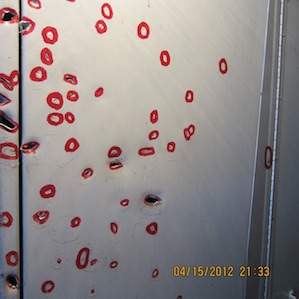
Bullet holes from the battle for the U.S.S. Pueblo
Until now, all of us have carefully avoided saying anything overtly critical about the North Korean government. For one, we know it will do no good.
J., our Western guide, tells us about a tourist he took around who interrogated the local guide so mercilessly that she finally broke into tears. I don't want to make Miss Choi cry. But, I take the opportunity provided by these close quarters to corner her. I tell her that many people consider the U.S. bombing of Hiroshima and Nagasaki to be a war crime, a crime against humanity that should never have happened.
Did Kim il-Sung ever talk about that, I ask, what did he think? At first Ms. Choi is flustered. She asks me to repeat the question, then says she will answer me outside. She never does. For an hour, we avoid each other's eyes.
The North Koreans do not acknowledge the U.S.'s role in defeating the Japanese -- apparently Kim il Sung did it single-handedly. Still, I cannot believe Miss Choi doesn't know how World War II ended. More likely, Kim il Sung never mentioned it, since either condemnation or approval would have him siding with the imperialists.
Up on deck, I am surprised to find a reporter from Fox News interviewing an aged Korean navy officer, one of the original captors of the Pueblo. The irony of this -- pitting one propaganda machine against another -- is downright comical. We tourists click away at the scene, until, making so much noise, the reporter tells everyone to go away. "I'm not part of your little circus," he snaps. D., a Vietnamese Dutch woman, a former political philosophy professor, an expert on Foucault turned gem dealer, roars back that this is not his ship. Ms. Choi quickly shuttles us back to the bus.
The spectacle of history is made perfectly manifest at the Fatherland Liberation Museum. The museum itself, with its poster board displays of photographs and text, has the look and feel of a high school science fair. Upstairs though, we witness an incredible sight -- a 360-degree panorama of a South Korean town "liberated" from the Americans during the Korean War. The background is painted, but the foreground contains real objects, fake trees, part of a burned out jeep. This is all viewed from a slowly rotating platform.
It is an incredible feat of artistry -- a low-tech virtual reality room. This exhibit only confirms what I've already suspected. In North Korea, history is never gray nor even black and white: It's always in amazing Technicolor.
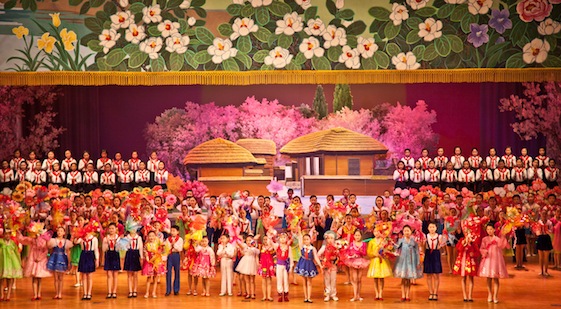
Kim il Sung's birthplace Mangyongdae is the set for a Hollywood-worthy children's performance, photo courtesy Roc LaMontagne
Nobody does spectacle like the DPRK